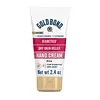Gold Bond Diabetics' Dry Skin Relief Hand Cream Versus Vaseline Clinical Care Cracked Heel Rescue Foot Cream
What's inside
What's inside
 Key Ingredients
Key Ingredients

No key ingredients
 Benefits
Benefits

 Concerns
Concerns

 Ingredients Side-by-side
Ingredients Side-by-side

Water
Skin ConditioningGlycerin
HumectantHydroxyethyl Urea
HumectantDimethicone
EmollientJojoba Esters
EmollientPetrolatum
EmollientCetyl Alcohol
EmollientDistearyldimonium Chloride
Aloe Barbadensis Leaf Juice
Skin ConditioningStearyl Alcohol
EmollientCyclopentasiloxane
EmollientCetearyl Alcohol
EmollientBehentrimonium Methosulfate
Glyceryl Stearate
EmollientMethyl Gluceth-20
HumectantHydrolyzed Jojoba Esters
Skin ConditioningButyrospermum Parkii Butter Extract
Skin ConditioningTocopheryl Acetate
AntioxidantBisabolol
MaskingChamomilla Recutita Flower Extract
MaskingAvena Sativa Kernel Extract
AbrasiveZingiber Officinale Root Extract
MaskingPolysorbate 60
EmulsifyingStearamidopropyl Pg-Dimonium Chloride Phosphate
Magnesium Ascorbyl Phosphate
AntioxidantPropylene Glycol
HumectantSteareth-21
CleansingPanthenol
Skin ConditioningButylene Glycol
HumectantDimethicone/Vinyl Dimethicone Crosspolymer
Skin ConditioningEDTA
Dipropylene Glycol
HumectantMethylparaben
PreservativeBoswellia Serrata Gum
MaskingDiazolidinyl Urea
PreservativeRetinyl Palmitate
Skin ConditioningPotassium Hydroxide
BufferingWater, Glycerin, Hydroxyethyl Urea, Dimethicone, Jojoba Esters, Petrolatum, Cetyl Alcohol, Distearyldimonium Chloride, Aloe Barbadensis Leaf Juice, Stearyl Alcohol, Cyclopentasiloxane, Cetearyl Alcohol, Behentrimonium Methosulfate, Glyceryl Stearate, Methyl Gluceth-20, Hydrolyzed Jojoba Esters, Butyrospermum Parkii Butter Extract, Tocopheryl Acetate, Bisabolol, Chamomilla Recutita Flower Extract, Avena Sativa Kernel Extract, Zingiber Officinale Root Extract, Polysorbate 60, Stearamidopropyl Pg-Dimonium Chloride Phosphate, Magnesium Ascorbyl Phosphate, Propylene Glycol, Steareth-21, Panthenol, Butylene Glycol, Dimethicone/Vinyl Dimethicone Crosspolymer, EDTA, Dipropylene Glycol, Methylparaben, Boswellia Serrata Gum, Diazolidinyl Urea, Retinyl Palmitate, Potassium Hydroxide
Water
Skin ConditioningGlycerin
HumectantDimethicone
EmollientPetrolatum
EmollientCopernicia Cerifera Wax
Isopropyl Myristate
EmollientCetearyl Alcohol
EmollientGlyceryl Hydroxystearate
EmollientDimethicone Crosspolymer
Emulsion StabilisingHydroxystearic Acid
CleansingCaprylyl Glycol
EmollientCetearyl Glucoside
EmulsifyingSodium Cetearyl Sulfate
CleansingCetyl Palmitate
EmollientPhenoxyethanol
PreservativeAmmonium Acryloyldimethyltaurate/Vp Copolymer
Tetrasodium EDTA
Stearic Acid
CleansingWater, Glycerin, Dimethicone, Petrolatum, Copernicia Cerifera Wax, Isopropyl Myristate, Cetearyl Alcohol, Glyceryl Hydroxystearate, Dimethicone Crosspolymer, Hydroxystearic Acid, Caprylyl Glycol, Cetearyl Glucoside, Sodium Cetearyl Sulfate, Cetyl Palmitate, Phenoxyethanol, Ammonium Acryloyldimethyltaurate/Vp Copolymer, Tetrasodium EDTA, Stearic Acid
Ingredients Explained
These ingredients are found in both products.
Ingredients higher up in an ingredient list are typically present in a larger amount.
Cetearyl alcohol is a mixture of two fatty alcohols: cetyl alcohol and stearyl alcohol. It is mainly used as an emulsifier. Emulsifiers help prevent the separation of oils and products. Due to its composition, it can also be used to thicken a product or help create foam.
Cetearyl alcohol is an emollient. Emollients help soothe and hydrate the skin by trapping moisture.
Studies show Cetearyl alcohol is non-toxic and non-irritating. The FDA allows products labeled "alcohol-free" to have fatty alcohols.
This ingredient is usually derived from plant oils such as palm, vegetable, or coconut oils. There is debate on whether this ingredient will cause acne.
Due to the fatty acid base, this ingredient may not be Malassezia folliculitis safe.
Learn more about Cetearyl AlcoholDimethicone is a type of synthetic silicone created from natural materials such as quartz.
What it does:
Dimethicone comes in different viscosities:
Depending on the viscosity, dimethicone has different properties.
Ingredients lists don't always show which type is used, so we recommend reaching out to the brand if you have questions about the viscosity.
This ingredient is unlikely to cause irritation because it does not get absorbed into skin. However, people with silicone allergies should be careful about using this ingredient.
Note: Dimethicone may contribute to pilling. This is because it is not oil or water soluble, so pilling may occur when layered with products. When mixed with heavy oils in a formula, the outcome is also quite greasy.
Learn more about DimethiconeGlycerin is already naturally found in your skin. It helps moisturize and protect your skin.
A study from 2016 found glycerin to be more effective as a humectant than AHAs and hyaluronic acid.
As a humectant, it helps the skin stay hydrated by pulling moisture to your skin. The low molecular weight of glycerin allows it to pull moisture into the deeper layers of your skin.
Hydrated skin improves your skin barrier; Your skin barrier helps protect against irritants and bacteria.
Glycerin has also been found to have antimicrobial and antiviral properties. Due to these properties, glycerin is often used in wound and burn treatments.
In cosmetics, glycerin is usually derived from plants such as soybean or palm. However, it can also be sourced from animals, such as tallow or animal fat.
This ingredient is organic, colorless, odorless, and non-toxic.
Glycerin is the name for this ingredient in American English. British English uses Glycerol/Glycerine.
Learn more about GlycerinPetrolatum is more commonly known as petroleum jelly. It is created by mixing waxes and mineral oils.
This ingredient is effective at reducing water loss by 99%. This is because it is an occlusive. Occlusives create a hydrophobic barrier on the skin to prevent evaporation. This property makes it great for hydrating dry skin.
Pro tip: Use occlusives, such as this ingredient, on damp skin for the best results.
The quality or origin of petrolatum is only known when disclosed by the brand. Most cosmetic petrolatum has gone through several purification stages.
Another benefit of occlusives is it protects your skin against infection or allergies.
Petrolatum may not be safe for fungal-acne. Studies show mineral oil / petroleum leads to the growth of M. Furfur, a type of yeast.
Learn more about PetrolatumWater. It's the most common cosmetic ingredient of all. You'll usually see it at the top of ingredient lists, meaning that it makes up the largest part of the product.
So why is it so popular? Water most often acts as a solvent - this means that it helps dissolve other ingredients into the formulation.
You'll also recognize water as that liquid we all need to stay alive. If you see this, drink a glass of water. Stay hydrated!
Learn more about Water